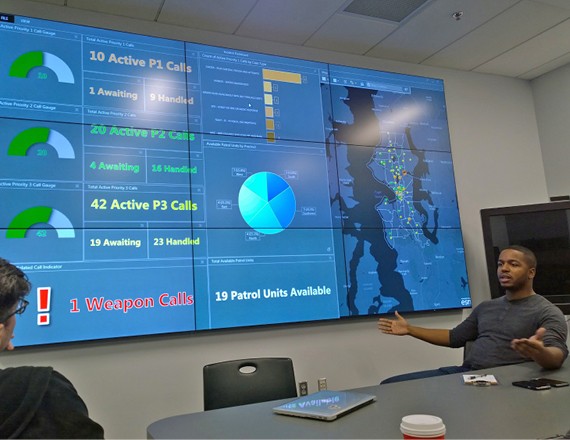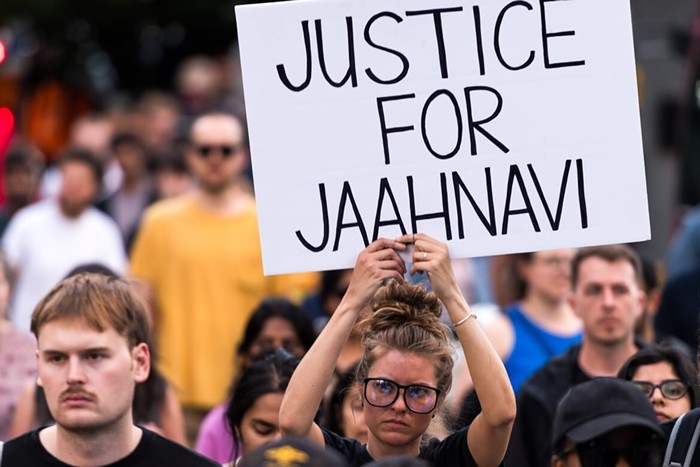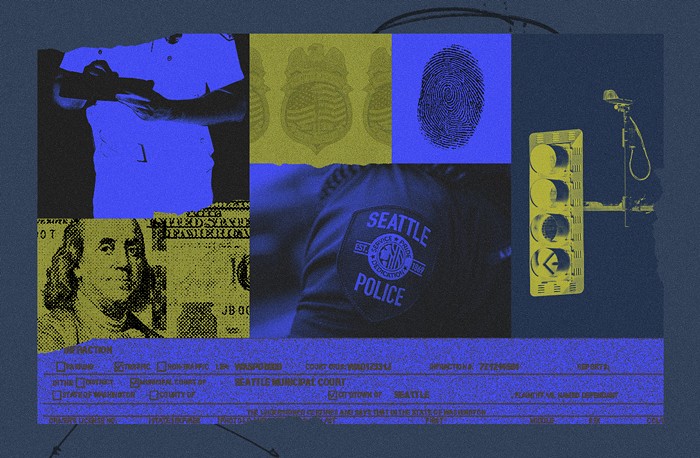When reporters shuffled into a room on the seventh floor of Seattle Police Department headquarters on October 7, we had no idea what to expect. Once inside, we whirled around to get our bearings. A giant screen covering the closest wall flashed with moving dots on a map and colored gauges, across from rows of computer terminals.
What looks like a miniature version of NASA's mission control room, it turns out, is Seattle's new information hub for "agile policing"—the Real Time Crime Center (RTCC), funded by a $411,000 grant from the Department of Justice, the same agency that forced the department into a federally monitored reform process in 2012 to address concerns about racial bias and excessive force.
The American Civil Liberties Union of Washington's director of technology and liberty, Jared Friend, was watching a live stream of the press conference as it unfolded. His ears perked up when he heard the department's chief operating officer, Mike Wagers, point to one of the screens and say, "It's trying to forecast the crime that we think will occur."
Wagers stopped abruptly and restarted: "I shouldn't say [that]... It's forecasting what we believe, based on historical data, what crime should be occurring out there. And then when we see the spike, [we] redeploy as quickly as possible."
Friend had already been in discussions with Wagers about the dangers of so-called predictive policing, and he was alarmed to see the department launching technology that might be "forecasting" crime. The SPD has been forced to backtrack on new technologies in the face of privacy concerns before: A few years ago, the department excitedly launched a drone program, only to kill the program after an outcry. And in 2013, it deactivated its citywide wireless mesh network after The Stranger reported on ways the network could be used to conduct surveillance.
The new crime center prompted Friend to take to the ACLU's website, writing on October 20, "Although this may sound like a smart move to incorporate analytics technology in law enforcement, in practice it would perpetuate existing institutional racism in policing." He called for "proper oversight and community input."
Wagers responded curtly on Twitter: "Could not be further from the truth."
So who's right?
First, some explaining: The primary goal of the Real Time Crime Center is to enable faster responses to 911 calls. That big screen on the wall shows where patrol cars currently are and breaks down the number of active calls regarding different kinds of crime at any one time. The department stresses that the particular program that's so concerning to the ACLU accounts for only a fraction of the center's activity.
But how does that program work, exactly?
According to Brandon Bouier, an SPD analyst and program manager, it uses 911 call data going back to 2008 in order to create an expected baseline of crimes. Take, for example, a hypothetical 10 car prowls per week on Queen Anne. The software in the crime center would use that baseline to detect anomalies by flagging unusually high or low levels of crime—say, a spike to 20 car prowls in a week in that area. If such a spike was detected, the crime center's staff would examine the anomaly and decide how to deploy police in response, in real time. "The anomalies give us something to focus on when we have these reams of information," Bouier said. But human beings make the final call on whether to act on them. "It's not like we have an automated system, like Skynet"—the artificial intelligence overlord from the Terminator films—"that's going to detect anomalies and automatically dispatch the officers."
The precise method for tuning those baselines and calculating an anomaly isn't in place yet. In fact, the program hasn't even launched yet, though the RTCC itself is active—something that wasn't at all clear from the department's big press conference. Bouier says the department is waiting on Via Science, a Boston-based data analytics firm, to deliver the software that will handle the crime number crunching. Police chief Kathleen O'Toole joined the company's advisory board in 2013. It's not clear how the company was selected for the work, but the pick was vetted by the Seattle Ethics and Elections Commission in order to address conflict-of-interest concerns. Friend's worry is that the 911 call data used to set the crime baselines isn't neutral. It's racially biased because institutional racism is real; communities of color are historically less trustful of police, leading them to report fewer crimes; and white communities often over-report crimes. This could create a feedback loop in which certain neighborhoods get singled out by the software as being more prone to crime based on biased inputs, increased police presence is triggered for those neighborhoods based on the software's statistical analysis, and then those neighborhoods receive heightened policing that's based more on prejudiced 911 callers than on a true representation of crime patterns.
I couldn't find any local data on racial bias in 911 calls, but there's no disagreement that the calls are biased. To take one example: Earlier this year, a purported police officer complained on a national policing forum about a call he received of "suspicious activity." In fact, the activity was two black men trying to jump-start their car. "If you're going to be a racist, stereotypical jerk... keep it to yourself," he wrote. The post went viral.
On this point, it turns out, there's no daylight between the ACLU and the SPD. In a meeting at the new crime center on November 3, Friend laid out his concerns. And while Bouier and Friend vehemently disagreed on whether the terminology of "prediction" or "forecasting" is applicable to the new technology—Bouier doesn't believe it is—he agreed that the data itself isn't objective. "We all in the department are fully aware of the inherent bias in the data we're working with," he said. "That said, that's all we have. We have to work with what we have." (Bouier is black, and he said he's been profiled by police before.)
Friend came out of that meeting encouraged by the department's openness. And Bouier pledged to drop Via Science as a partner if their work isn't rigorous enough. Sean Whitcomb, a police department spokesperson, wondered aloud whether it would be better to use incident reports—which are based on officer investigations, instead of mere 911 calls—to create those baselines of expected crime levels.
"The department needs to internalize that the data is inherently problematic, and it needs to think about ways to correct for those problems," Friend said on his way out from the meeting. "And if the value of using this data isn't really strong, and it's outweighed by those concerns [about bias], they need to decide not to move forward with it. The good news, based on what I heard in the meeting, is that they're willing to do that." ![]()



















